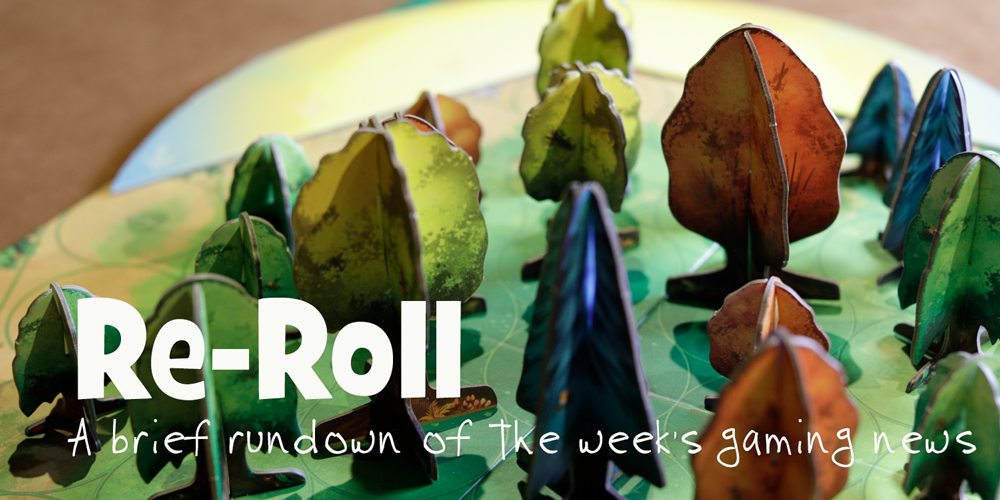The portal has been opened, and factions from the different elements have arrived in Eldervale. Fight monsters, delve dungeons, and settle the land to become the new Ruler of Eldervale.
What Is Dwellings of Eldervale?
Dwellings of Eldervale is a worker placement, tableau building, and area control game for 1-5 players, ages 14 and up, and takes about 60-150 minutes to play. While the subject matter is perfectly suitable for younger audiences, there are a lot of moving pieces in the game, and smaller children may have difficulty with that level of complexity. There are three different versions of the game available from the Breaking Games webstore. The standard edition is $99.99, the deluxe edition is $149.99, and the legendary edition is $199.99. Additionally, there are limited-edition covers available for each edition at an increased cost.
At the time of this writing, not all of the editions are available for purchase. However, Breaking Games is planning on a “micro-release” within the next couple of months where more stock will be available. If you want to buy the game but don’t see the edition in stock that you’re interested in, you can sign up for the Dwellings mailing list to be notified when that micro-release happens.
Dwellings of Eldervale was designed by Luke Laurie and published by Breaking Games, with illustrations by Sergio Chaves, Anton Fadeev, Leesha Hannigan, Irina Kuzmina, Merilliza Chan, Nathanael Mortensen, Sasha Radivojevic, Sam Turner, Brian Valeza, and Frank Wade.

Dwellings of Eldervale Components
There are three different editions of the game: Standard, Deluxe, and Legendary. Here are what each edition contains:
Standard Edition
- 8 Dual-sided Player Mats in Custom Gametrayz
- 6 Dungeon, Resource, Hex, Core Gametrayz
- 72 Custom Meeples, 8 Player Colors
- 48 Custom Meeple Dwellings, 8 Player Colors
- 48 Wooden Score Markers, 8 Player Colors
- 53 Marbled D6 Dice, 8 Player/Monster Colors
- 1 Elemental Scoreboard and Underworld
- 32 Unique Elemental and Ruin Hex Tiles
- 24 Ghosts of Eldervale Solo Mode Cards
- 1 Ghosts of Eldervale Playmat & Watcher Meeple
- 60 Magic Cards
- 104 Adventure Cards, with Unique Fantasy Art
- 8 Starter Player Faction Cards
- 9 Monster Cards, Custom Art/Abilities
- 9 Monster Standees & 12 Plastic Stands
- 9 Glass Bead “Orbs”
- 120 Cardboard Resources
- 10 Cardboard Tactics & Trove Tokens
- 5 Player Reference Aides, Appendix Booklet
Deluxe Edition
Everything in the Standard edition, plus:
- 9 Plastic 50mm Miniatures
- 20 Deluxe Custom Metal Coins
- 100 Wooden Resources
Legendary Edition
Everything from the Standard and Deluxe edition, plus:
- 9 Legendary Monster 50mm Miniatures
- 9 Sound FX bases
- 1 Bifrost Bridge Hex Tile
- 1 Shapeshifter Mercenary Miniature
Breaking Games sent me a copy of the Legendary Edition for evaluation.
Dwellings of Eldervale is a game that’s packed with content. As opposed to some of those board games that have big boxes with plenty of empty space inside, this box uses pretty much every square inch of space, at least with the Legendary edition. You won’t have a problem putting everything back in the box once you play, either, thanks to the included custom Gametrayz. Most of the Gametrayz aren’t just used for storage, but are also used on the table during your game.

There are eight player trays, one for each elemental faction in the game. Each tray comes with a thick cardboard lid which also functions as a player board. The player board is double-sided, with two distinctly different playable factions for each element.
The tray itself holds all of the player’s markers, meeples, dwellings, colored dice, and resources. The resource bins are helpfully marked as “Max 5” as that is the limit for each of those resources. Additionally, there are 4 slots to hold treasure tokens.

Similarly, the dungeon trays will be used throughout a game. These hold the cards that will be available for acquisition when a player places a unit on the Dungeon tile, as well as the treasure tokens that will be placed on Realm tiles. There are two trays, holding cards and tokens representing the eight elements in the game.

There are two resource trays, to hold the various resources acquired during the game. Magic cards, which can be used for various effects, may also be used as a resource. As you can see, the lid for the tray also has molded the outlines of these resources.
In the picture above, you can see the wooden tokens and metal coins that are available in the deluxe and legendary editions of Dwellings of Eldervale. However, should you opt for the standard version, they’ve done a very nice job with the punchable cardboard pieces:

The standard edition of the game includes cardboard standees with nice illustrations for the monsters. But if you get the deluxe version you’ll get this tray of monster miniatures as well:
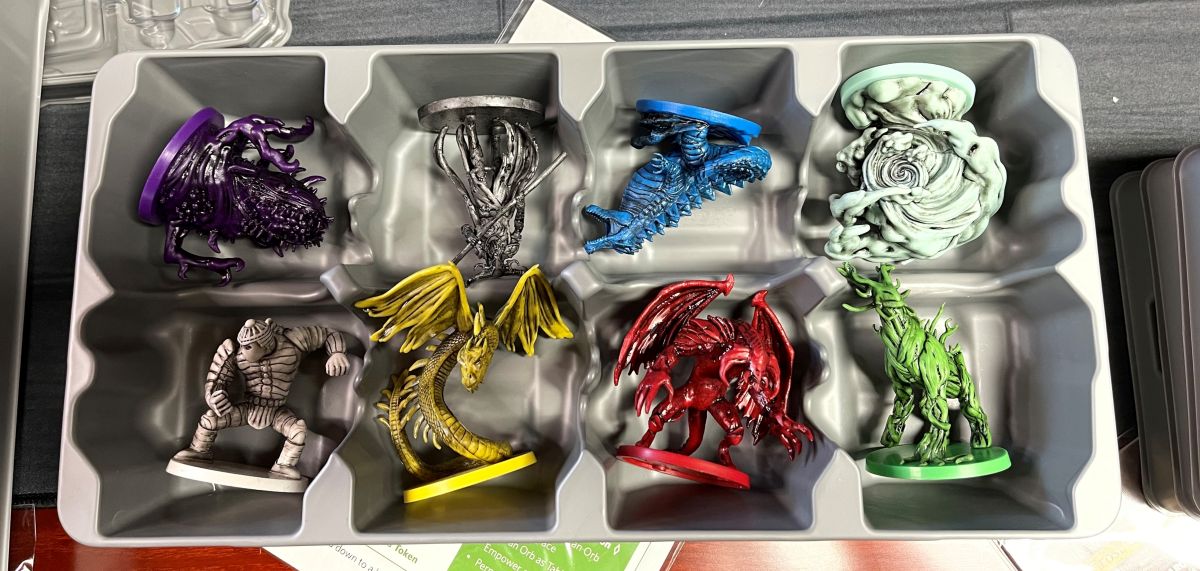
And should you have the legendary edition, you’ll also get a second tray, filled with the alternate elemental monsters:
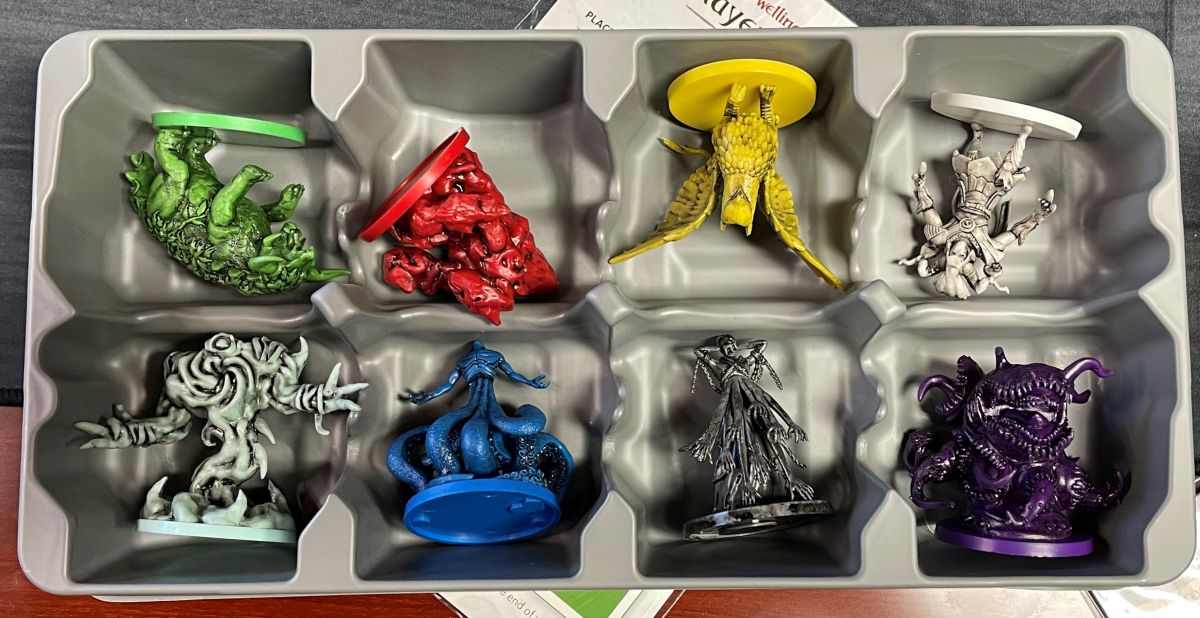
All of the monsters are nicely sculpted, and they come with an ink wash. This is a process where a dark fluid shading color is painted along the miniatures, and the shade settles into the cracks and crevices of the model, helping to bring out the details. It’s generally not seen as a standard practice in that many other board games, thought the Unmatched series is an exception. And if you’re not planning on painting your miniatures, ink-washed miniatures look great on the table:

If you get the legendary edition, you’ll also get nine motion-activated Sound FX bases, colored to match each of the elements as well as a grey base for the Mother of Dragons mini-expansion and the Frost Giant mini-expansion. All the bases have switches on the bottom to play a different sound if it’s a deluxe edition monster or a legendary edition one. While these bases are entirely unnecessary for playing the game, there’s something really fun about a monster roaring as it charges a unit on the map. I did test out each of the bases from my game and they all worked great. If you’re interested, here’s a video which shows off the different monster sounds:
As you’ve seen, there are a lot of components…and I haven’t even discussed all of them! There is also an Elemental scoreboard and multiple hex tiles made from the same thick cardboard as the player boards. These share the same colorful, thematic artwork that also runs through the various cards. All of the components, no matter which edition you choose, look and feel great on the game table.
How to Play Dwellings of Eldervale
You can download a copy of the rulebook here.
The Goal
The goal of Dwellings of Eldervale is to acquire the most victory points by building Dwellings, adventuring in the dungeon, and defeating your foes in combat.
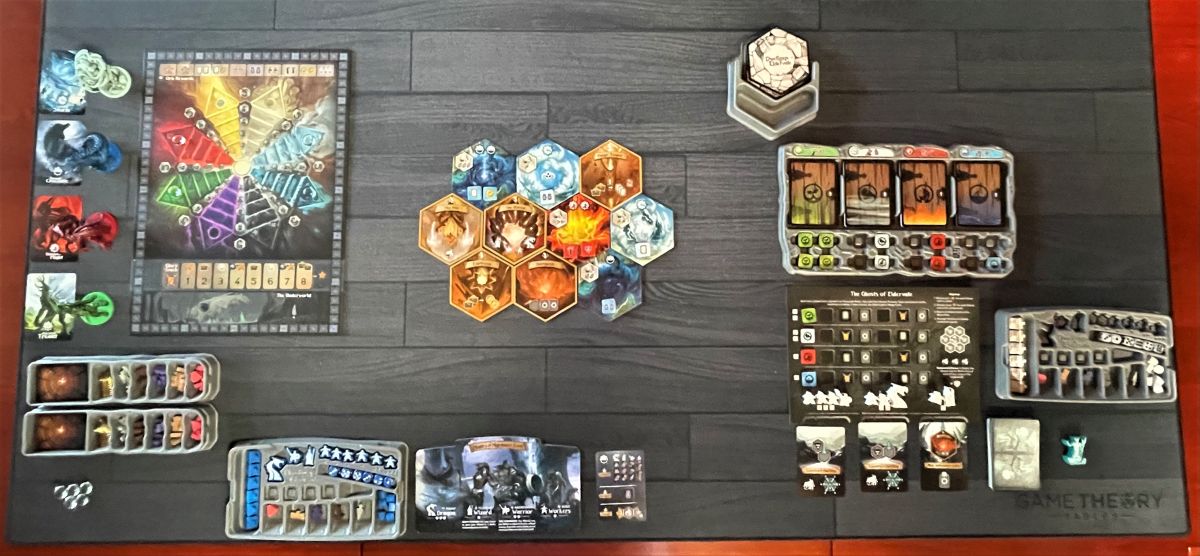
Setup
Place the Elemental scoreboard at one end of the table.
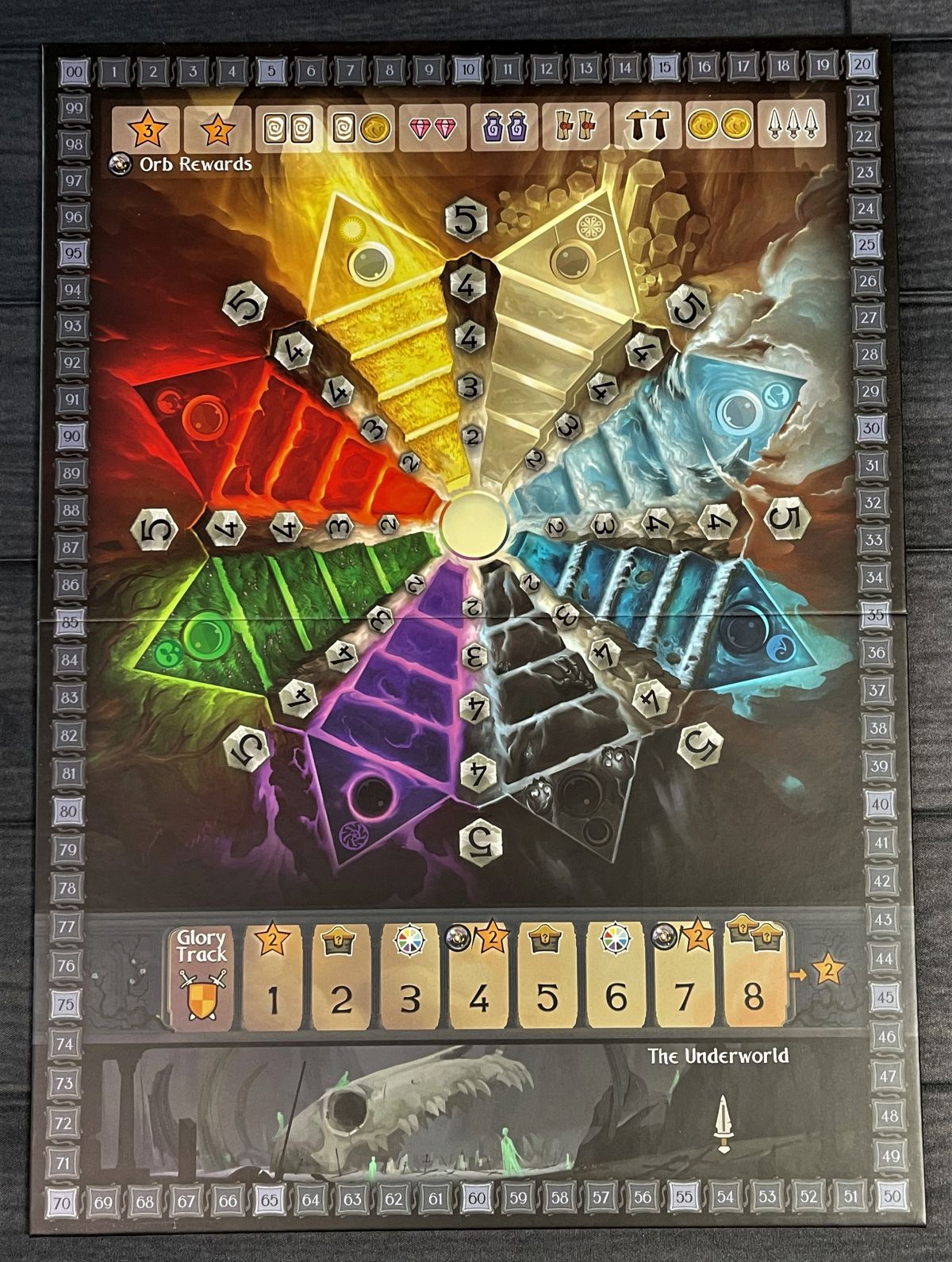
Each player then chooses one of the sixteen available factions, taking the player tray and Elemental Starter card matching the faction they chose. Players place their player board in front of them as a ready area for their units.
Players roll off to choose the First player. That player takes one of their scoring markers and places it on the victory point track on the scoreboard on the “1”. Going clockwise, each player then places their scoring marker on the next open number.
Determine which Elements will be used in the game. The Elements will be whichever ones the players have chosen for their factions, plus 2 additional Elements chosen by any agreed-upon means. For each element being used, you will need to gather the 3 corresponding Elemental Realm hexes, 1 Monster card along with its standee or miniature, and 1 Orb. Put the hexes aside for now. Place the Monster cards next to the scoreboard, and place an orb at the end of each elemental track that is being used for that game.
Take the Dungeon trays and turn the Doorway cards for the elements being used in the game faceup on their respective decks.

To build the game map, take all of the Elemental Realm tiles matching the elements being used in the game, and shuffle them together. Then draw and reveal a number based on how many players are in the game: 5 for a 2-player game, 7 for 3 players, or 8 for 4-5 players. If more than one Lair is drawn, place it at the bottom of the Realm stack and draw again. Lairs have horned skulls, as seen in the water tile above.
Take the Ruins tiles and shuffle them in with the revealed Realm tiles. Then draw each of the tiles and build them in a pattern as shown on page 5 of the main rulebook. Then reshuffle the Realm stack, and place it face down in the Discard tray.
Place a stack of Treasure tokens from the Dungeon tray faceup onto each token space on a Realm tile. If there is a Lair showing, place the miniature or standee matching the element onto that hex. Place the Resource trays, Discard tray, and any Mercenaries(if used) within easy reach on the table.
Shuffle the Magic cards and deal out 5 to each player. Everyone puts 3 of their Workers onto the ready area of their Player board. If they are not already in the Player tray, each player should start with 1 Gem, 1 Portion, 1 Scroll, 1 Tool, and 1 Sword.
Each player places 1 scoring marker on the first space of the Elemental Power track that matches their element. 3 scoring markers should be placed beside the Elemental Power tracks.
Play is then ready to begin with the First player.

Gameplay
On each turn, you will either Place a Unit or Regroup. You may also perform any number of Free Actions.
Place a Unit
Choose a unit from the Ready area on your player board and place it into a Realm. Realms include both Elemental Realms and Ruins.
If you have no units currently in Eldervale, then you may place into any unoccupied Realm. If you already have other units in Eldervale, then you would place a unit in a Realm adjacent to one of your other units. Some units have additional placement rules: the Dragon can be placed up to 2 Realms away from one of your units, the Wizard can be placed in any unoccupied Realm, and the Warrior can be placed into an occupied Realm as your first placement. You may never place a unit in the same Realm with another of your units unless you have a faction ability or spell that specifically allows for that.
When you place a unit, you immediately get to take the Realm’s action. Additionally, a Battle may occur. If you place a unit in an Elemental Realm, you will draw a treasure token and place it in one of the 4 treasure slots on your player tray. If you place a unit in a Ruin, you will take the action specific to that Ruin:
- Mage Tower: spend 2 of any resource to draw 3 magic cards to your hand, and then discard 1 magic card from your hand.
- Summoning Portal: Pay the required resources to summon a unit from your Player tray to your Ready area. It can now be used for the rest of the game.
- Mill: Construct a Dwelling. Choose a worker in a Realm where there is not currently a Dwelling, and pay the resource cost indicated on that Realm to turn the worker into a Dwelling. When you construct a Dwelling, you will gain Victory Points, and also go up 1 or 2 levels on the Elemental Power track for the element where you built your Dwelling.
- Dungeon: Draw and place a Realm tile, and pay the resource costs to gain 1 or 2 Adventure cards. If you don’t purchase a second Adventure card, then choose a faceup card to move to the bottom of its deck. Any Adventure cards you gain will become part of your Tableau along with your Starter card.
- Fortress: Pay any 2 resources to gain 2 gold (which are a “wild” resource).

Battle
Every game of Dwellings of Eldervale has “Peaceful Beginnings” without any conflict. After every player has regrouped once, the kid gloves are off and Battles can occur.
A Battle can be between opponents, or against a Monster. If you place one of your units into a realm occupied by another player, then that triggers a Battle. If you place a unit into a Realm where a Monster is, then that triggers a Battle. If you place a unit into a Realm adjacent to a Monster, then the Monster will “rush in” to the same space as that unit, and it triggers a Battle.
These are the steps you’ll take during a Battle:
- Units adjacent to the Realm where Battle was initiated may move in and join the Battle. This can include units from any player, as long as they are adjacent.
- Each player determines the number of Battle Dice they will roll. This includes the dice for each unit, as well as 1 additional die for each Dwelling they have in or adjacent to the Realm where the Battle is taking place.
- Each player may spend Swords to add 1 Battle Die/Sword. However, a player will never roll more than 6 dice. Spells may also be played at this point.
- The Battle Dice are rolled and each player’s single highest die is compared. The highest result is the winner. If there is a tie, then each player’s next highest result is compared, and so on.
- The winner advances on the Glory track and gains the indicated reward. If a Monster is defeated, the player has the choice of advancing on the Glory track or gaining a level on the Elemental track matching the element of said monster.
- All losing players move their units into the Underworld, and gain 1 Sword for each unit placed there.

Regroup
If you Regroup, you will retrieve all of your units from Eldervale and the Underworld, taking Starter and Adventure card actions with some of those units. Here are the steps you will go through during a Regroup:
- One at a time, take a unit from Eldervale and place it on an available action space on either your Starter card or any Adventure cards in your tableau, and take the action shown, paying any associated resource costs. Some of these actions may include summoning new units, gathering resources, and building Dwellings.
- Return any units from the Underworld to the Ready area on your Player Board.
- Return any units from your Starter or Adventure cards to the Ready area on your Player Board.
- If you hired a Mercenary with gold on your previous turn, return them to the supply.
Free Actions
On your turn, you may do any of the following Free Actions:
- Discard a Treasure Token to gain the Resource(s) shown. This is the only free action that may be taken at any time in the game, not just on your turn.
- Slot a Treasure Token onto a card in your tableau.
- Play a Magic Card. There are three types of Magic Cards: Spells, Quests, and Prophecies. Spells can be played when indicated on their cards. Quests can be played when the requirements for the quest are met. Prophecies provide endgame scoring opportunities, so would not be played on your turn.
- Hire a Mercenary.
- Use a Tactics Token.
If you have any Orbs in your inventory, you may also as a Free Action on your turn do one of the following:
- Place the Orb on the Orb Reward space on the Elemental Scoring Board and receive the indicated reward.
- Slot the Orb onto an Input space on a Tableau card, making it cost zero resources when used during Regroup.
- Slot the Orb onto a Tableau card with an Orb space on the top left of the card, thereby Empowering that card.
- Slot an Orb onto a Mercenary card, permanently hiring that Mercenary.
Alternate Game Modes
For those looking to shake up their regular game of Dwellings of Eldervale, there are several alternate rules and Mini-Expansions included with the game:
The Oracle Ruin
Adding this Ruin to the game allows players to gain either 1 Adventure card or 1 Magic card when placing a unit on that Realm. This will also extend the length of the game.

Mercenaries
As a free action on your turn, you can use gold to hire the Mercenary and use it until your next Regroup action. If you hire the Mercenary with an Orb instead, it permanently joins your other units.
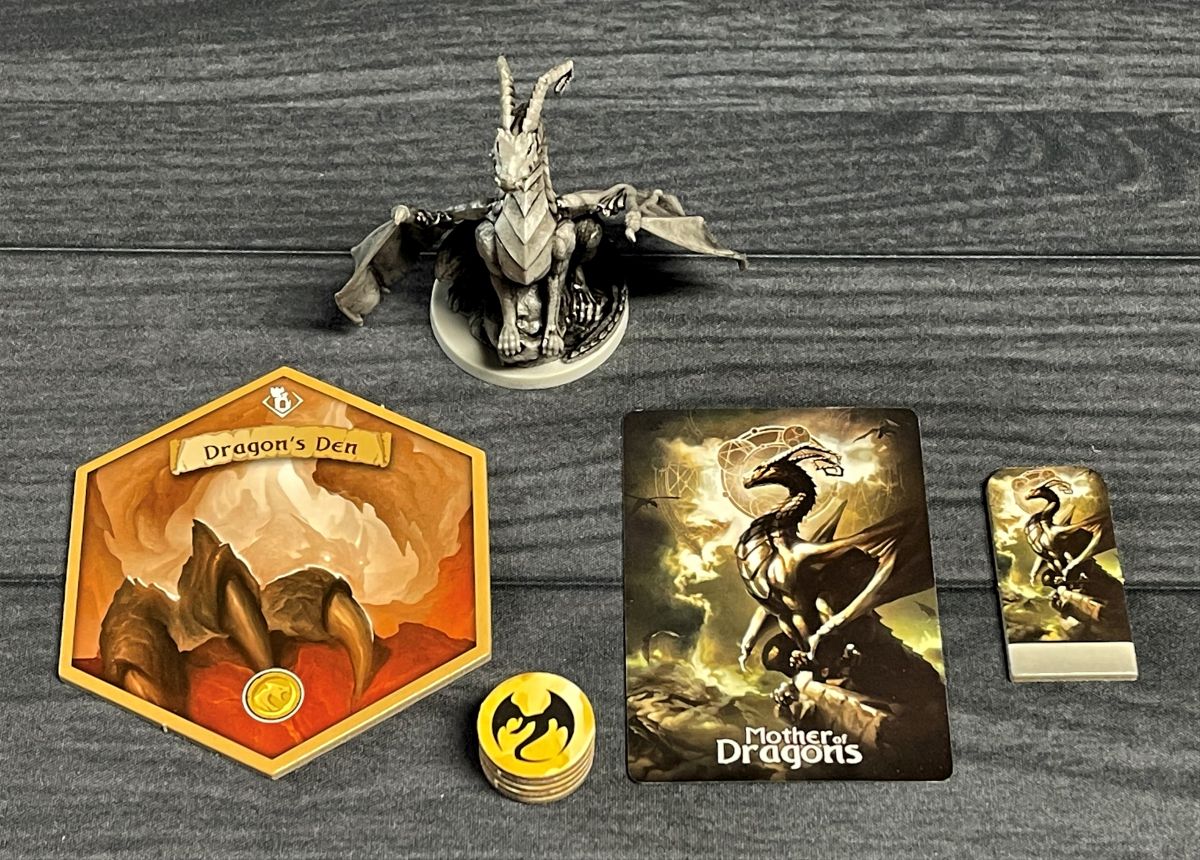
The Mother of Dragons Mini-Expansion
The Mother of Dragons mini-expansion has a Dragon guarding her treasure. When you place a unit in the Dragon’s den, you gain a gold. Defeating the Mother of Dragons gains you a Trove Token in addition to advancing on the Glory track.

The Frost Giant Mini-Expansion
When you draw the Bifrost Bridge tile, you place the 2 Victory Point tile adjacent to only one other Realm. Then, immediately draw another Realm tile and place it adjacent to the 10 Victory Point end of the Bifrost. Gain a Magic card when you place a unit on the Bifrost Bridge. Dwellings built adjacent to the 2 or 10 Victory Point sides will earn those respective points.
2v2 Mode
This mode modifies the rules so that you can play a 4-player game with teams.
Drafting Magic
Instead of being dealt a hand of 5 cards, everyone is dealt 7 cards and you will perform a draft, drawing individual cards to keep and passing the rest to the left several times.
Adventure Without Doorways
All the Door cards of the Dungeon decks are moved to the bottom of the deck, adding more unpredictability to the Adventure cards at the start of the game.
Tactics Tokens
These tokens may be used to keep units in Eldervale when they would otherwise be removed as casualties in a Battle. The tokens may be refreshed and used again by paying the associated cost.

The Ghosts of Eldervale Solo Mode
This game mode has been given a lot of attention, and has its own 7-page rulebook. You play a 2-Player game against a challenging AI opponent.
Game End
The end of the game is triggered by one of two means: either the last Realm is drawn from the Realm stack, or a player builds his 6th Dwelling. After one of those conditions occurs, every player including the one who triggered the end of the game gets one additional turn.
After the final turns have been taken, scoring begins.

Scoring
Players will earn Victory Points for the following:
- Unspent Orbs are worth 1VP
- VP equal to the number beside each of your markers on the Elemental Power track.
- Dwellings earn VP equal to where the marker is on the Elemental Power track matching the element of the Realm where the Dwelling is built.
- For each Dwelling you have built, you may score up to 3 Adventure cards of any Element. VP are determined by your position on the Elemental Power Track matching the element on the Adventure card.
- If you have an Adventure card with a Vault, it will be scored according to the text on that card.
- Prophecy cards will score the indicated VP, as long as the requirements to fulfill the prophecy on the card are met.
Whoever has the highest score wins and becomes the Ruler of Eldervale! Ties are broken by number of resources.
Dwellings of Eldervale is GeekDad Approved!
Why You Should Play Dwellings of Eldervale
Around the same time that I was reviewing the excellent Luke Laurie and Scott Caputo game Whistle Mountain, some gaming friends of mine were receiving their Kickstarter copies of Dwellings of Eldervale, another Luke Laurie game. And they would not shut up about how much they were enjoying it! If we weren’t in a pandemic, I could have just popped over and played with them, but sadly that’s not where we are right now. So I did the next best thing, and reached out to Breaking Games to see if I could get a copy of Dwellings to try out for myself, and see if it lived up to the hype.
If you couldn’t tell from the rest of this review, there’s a lot of game in Dwellings of Eldervale. The box, regardless of edition, comes with three separate books: the Rules of Play, The Ghosts of Eldervale solo rulebook, and a 20-page Appendix which describes the special rules for each faction, Adventure card, Magic card, and Monster in the game. And when you first unpack the game, you’re going to be looking at a lot of cardboard to punch and tokens to sort. All of this can make the game seem a little daunting at first glance.

Despite all of this, though, the basic rules are easy to pick up. The rulebooks are laid out well with frequent examples, and I didn’t have any trouble teaching the game to some friends when we played on Tabletop Simulator. There are a lot of fine points to the rules that players will need to keep in mind, such as the rules for scoring Victory Points when building Dwellings, but after referring to the rules a couple of times during a game, they’re easy enough to remember. Still, I can almost guarantee there will be some small things that you get wrong the first couple of times that you play, unless you read the rules very carefully on your first outing. For example, it’s easy enough to miss the sentence that states that Ruins are also Realms…especially as the other type of Realm is called “Elemental Realm.”
I will be honest and tell you that I haven’t played with all of the alternate game modes that are included with Dwellings of Eldervale. The game is rich and enjoyable before adding any additional content. There are sixteen different factions in the game, all of them with different special abilities for their units. The map will be different each game as well, thanks to the way the tiles are shuffled and drawn at the beginning of the game. These two factors alone provide a ton of replayability, as your strategies will have to adapt to those variables.

During one game on Tabletop Simulator, a random map was automatically generated for us that had all of the Ruins running through the middle, almost like a chasm. This had us all jockeying for position immediately adjacent to the middle, so we could take advantage of the extra victory points for building Dwellings. It sometimes made unit placement challenging as well, as you wouldn’t always want to use a Ruin’s action on your turn, but may need to move through one to get to a specific Realm.
Battles are quick and fun. While you can play additional Swords and Magic cards during a Battle, they ultimately will hinge on dice rolls. While not a likely outcome, you could roll six dice with your opponent rolling only 1 die and still lose, if your opponent rolls a six and you don’t. There is a certain amount of risk involved as your units may lose and end up in the Underworld, thus keeping them from being used to perform actions during Regroup. However, there are some Magic and Adventure cards which can mitigate that. And no matter how well you put the odds in your favor, you never know what Magic cards your opponent has in their hand that can affect the outcome. For example, when I was playing solo, I ended up in the following Battle:

I was the blue player. In the example above, the combat is evenly matched: the Ghost player gets one die for each of workers, and I got 1 die for my worker, and an additional die for having a Dwelling in the Realm we were battling in(The Watcher doesn’t participate in battles). So it was an even Battle, but I wanted to do my best to win. And so, I played one of my Magic cards:

The Polymorph spell allowed me to swap my worker out for another of my units…in this case a Dragon, which rolls 3 dice in combat. Suddenly, I had a significant edge…and luckily, I did roll higher than my opponent. I stayed in that Realm, while the Ghost workers went to the Underworld.
The Gametrayz work fantastically for Dwellings of Eldervale. Not only do they keep your game neatly organized, but they make setting up to playa breeze. A player just grabs the Player tray with the faction that they’d like to play, and they have all the components they need to start the game. After you play, it just takes a few minutes to get everything back into the trays, ready for your next game.
Dwellings of Eldervale is a wonderfully engaging game with out of this world production values. With just the Standard edition of the game, you’ll get a ton of content and a game that you’re unlikely to get bored with anytime soon. The Deluxe and Legendary editions both provide a bit of extra content, and a lot of bling. Your mileage may vary on the latter: some people are perfectly happy with cardboard standees for monsters. But for others, moving a chonky monster miniature around on a sound base that literally roars as the monster attacks will “spark joy,” as Marie Kondo would say.
If you’re interested in grabbing a copy, there are still some copies of the Deluxe edition of Dwellings of Eldervale with the limited Croc cover available on the Breaking Games website at the time of this writing. Or, if you’d prefer one of the other editions of the game, they should be available to purchase in the next few months when Breaking Games does their other micro-release. In the meanwhile, if you have Tabletop Simulator, there is an excellent scripted Dwellings of Eldervale mod that will allow you to play while you’re waiting to get ahold of your own physical copy of the game.
Click here to see all our tabletop game reviews.
![]() To subscribe to GeekDad’s tabletop gaming coverage, please copy this link and add it to your RSS reader.
To subscribe to GeekDad’s tabletop gaming coverage, please copy this link and add it to your RSS reader.
Disclosure: GeekDad received a copy of this game for review purposes.





